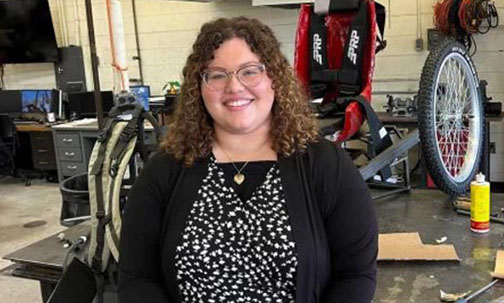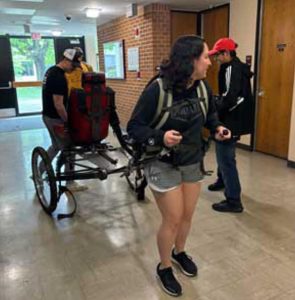by Tim Crosby
CARBONDALE, Ill. – A team of engineering students from Southern Illinois University Carbondale recently came together to assist people with mobility difficulties who struggle with getting out into nature, where hiking trails and off-road paths can present challenges.
For their required senior capstone project, the mechanical engineering students designed and built a custom adaptive mobility device. Essentially a hiking cart, the device will allow people with disabilities to use the trails at Touch of Nature Outdoor Education Center with the assistance of a hiking partner.
The item is now being used for TON programs and soon will be available to the public for use there.
Senior capstone project
As a requirement for their undergraduate degree in mechanical engineering, students must complete a senior capstone project. The project allows them to solve a real-world engineering problem from concept through design and fabrication, thus preparing for the challenges of their professional careers.

Anna Carter, student team leader, said as the students reached their senior year at SIU, they decided they wanted to build something that would give back to the community.
“We were all discussing the kind of project we wanted to pursue,” said Carter, a native of Du Quoin. “Many senior projects from the past were done for competitions for student organizations, and they’re on display at the Engineering Building on campus. They are excellent examples of what our program is all about — innovation and application of the concepts we’ve learned — and it was inspiring to see them as we began our own project. But we decided that we wanted to build something practical and useful that would help someone else.”
Opening up nature
Enter staff at SIU’s Touch of Nature, an outdoor learning laboratory and activity hub for SIU students, scientists and the public located near Giant City State Park, south of Carbondale.

Last year, staff members put out the call for a machine that would make it possible for people with disabilities to enjoy the trails winding through the preserve, connecting camping areas and providing views of Little Grassy Lake the popular Rocky Ledges site.
Such hiking carts are hard to find, however, as they are not mass-produced. That also means they are often unaffordable.
“Our mission is to enhance lives through outdoor experiences,” said Brian Croft, TON director. “To do this, we address access issues, including acquiring specialized equipment. Such equipment is often very expensive, however, so partnering with students helped us bring it to SIU and Touch of Nature.”
Getting together to solve a problem
TON staff outlined the challenges for the seniors, looking at specifications such as the maximum width and slopes of various trails and other requirements. The team then began designing the machine using computer-aided design during fall semester of that year, eventually submitting the frame design to a company that fabricates computer-aided drawings. The team received those parts in April and began welding them together.
While this was going on, the team also began ordering other needed off-the-shelf components and parts. Supply chain issues would inadvertently teach the upcoming engineers to deal with such real-world problems that sometimes arise.
“We had a few parts that were delayed multiple times, which hindered our progress overall,” Carter said. “For instance, the shocks were ordered months before our final project was due to be completed for our final presentations, but they didn’t get to us in time. So, we manufactured the cart around the shocks and installed them once they came in. But this also delayed our testing.”
Another challenge faced by the team was learning design on the fly, Carter said. While large companies have the luxury of building and testing prototypes before delivering them to the public, the team had one shot.
“There aren’t many versions of this adaptive device that have been built, so we had very little to compare our work to,” Carter said. “There were many aspects of the cart that we realized we had missed as we began manufacturing and assembling, so we were quick to come up with solutions, which usually required more manufacturing of parts and more time to spend.”
Actual assembly of the device took several months, but final testing was completed on May 3. Touch of Nature took delivery May 9.
“The overall cost was around $2,400, which is a fraction of the cost that others are selling them for,” Carter said. “It was a whirlwind of long days and long nights, and testing to get out as many kinks as possible, but we designed a great adaptive device that I have full confidence in,” Carter said.
Croft said the device is being used for all Touch of Nature programs, including outdoor education and inclusive recreation, campus and community-based programs. The center also is working on a plan to provide community members with access to the equipment.
“We believe that outdoor experiences are a right for everyone,” Croft said. “By providing specialized equipment like this, we can open up the outdoors to people who might not otherwise have the means or ability to experience the beauty of Southern Illinois so they can enjoy and benefit from our natural surroundings.”
Lessons learned
Carter said honing communication skills was one of the biggest challenges and lessons the team mastered along the bumpy road to success.
“My team and I had to communicate so much with each other, our advisers and our suppliers, and it didn’t always go smoothly,” she said. “We all had ideas of how to design and build this adaptive device, so discussion of final design was sometimes very stimulating because we all had great ideas to add. Sometimes the ideas clashed, and we had to figure out which was best for the cart and the rider, not just what made one of us happy.
“Personally, I felt like my communication skills and ability to work with others became much better by the end of the year. I feel confident about my ability to communicate with my co-workers in this new job that I just began. And I would say that my friends would agree as they’re beginning their careers or grad school.”
